 |
Top Destinations |
|
|
|
 |
Travel Tools |
|
|
|
 |
|
|
Xian Attractions - Top sightseeing and things to see
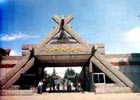 In the present-day Banpo village, about five kilometers to the east from
Xi'an, lies the actual and complete archaeological site of a Neolithic
village---the Banpo Site, dating back to 6000 years. It is a typical village
of that time, discovered in the spring of 1953. Later, after five large-scale
digs of excavation organized by Chinese Academy of Sciences, an area of
approximate 10,000 square meter was excavated, covering one fifth of the
total site area. Among the excavated finds are 45 house sites, 2 penned
sites, 6 pottery-making kilns, over 200 stronge pits, over 250 burial
jars of adults and children, over 1,000 pieces of tools and utensils,
as well as thousands of kernels, animal bones and rotten millets. An on-the-site
museum was set up here in 1985, and named after the present place where
it was discovered "Xi'an Banpo Museum". Apart from the relic
exhibition rooms, a 3,000 square-meter on-the-site great hall of the remains
was set up for protection of the site. The Banpo Museum is one of the
historical sites designated for state protection.
In the present-day Banpo village, about five kilometers to the east from
Xi'an, lies the actual and complete archaeological site of a Neolithic
village---the Banpo Site, dating back to 6000 years. It is a typical village
of that time, discovered in the spring of 1953. Later, after five large-scale
digs of excavation organized by Chinese Academy of Sciences, an area of
approximate 10,000 square meter was excavated, covering one fifth of the
total site area. Among the excavated finds are 45 house sites, 2 penned
sites, 6 pottery-making kilns, over 200 stronge pits, over 250 burial
jars of adults and children, over 1,000 pieces of tools and utensils,
as well as thousands of kernels, animal bones and rotten millets. An on-the-site
museum was set up here in 1985, and named after the present place where
it was discovered "Xi'an Banpo Museum". Apart from the relic
exhibition rooms, a 3,000 square-meter on-the-site great hall of the remains
was set up for protection of the site. The Banpo Museum is one of the
historical sites designated for state protection.
l
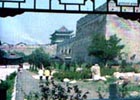 The City Wall of Xian is just at the center of Xian municipality, in a
rectangular shape and with the length from east to west a little longer
than that from south to north. The perimeter of the city wall is 11.9
kilometers, with four gates constructed in the four directions of east,
south, west and north. The construction system of the city gates is in
a four-rampart and 12-gate style. The Northern City Gate is called Anyuan
Gate, the Southern City Gate is called Yong'an Gate, the West City Gate
is called Anding Gate, and the East City Gate is called Changle Gate.
It was rebuilt and extended on the base of the original Tang Dynasty Palace
Wall from the seventh year to the eleventh year of Hongwu in Ming Dynasty
(from 1374 to 1378 AD). It has a history of 600 years up to now and it
is also the most large, solid and complete city wall which has survived
through the long history in China.
The City Wall of Xian is just at the center of Xian municipality, in a
rectangular shape and with the length from east to west a little longer
than that from south to north. The perimeter of the city wall is 11.9
kilometers, with four gates constructed in the four directions of east,
south, west and north. The construction system of the city gates is in
a four-rampart and 12-gate style. The Northern City Gate is called Anyuan
Gate, the Southern City Gate is called Yong'an Gate, the West City Gate
is called Anding Gate, and the East City Gate is called Changle Gate.
It was rebuilt and extended on the base of the original Tang Dynasty Palace
Wall from the seventh year to the eleventh year of Hongwu in Ming Dynasty
(from 1374 to 1378 AD). It has a history of 600 years up to now and it
is also the most large, solid and complete city wall which has survived
through the long history in China.
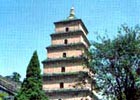 The Big Wild Goose Pagoda, located in Ci'en Temple, is about 4 kilometers
south of Xian City. In 648 AD Tang emperor Gao Zong (Li Zhi), then still
a crown prince, had it built to memorize his mother. The Temple then obtained
its name Da Ci'en Temple, meaning the Thanksgiving Temple. According to
the records, the temple, with more than 10 courtyards, contained 1,897
marvelous chambers altogether.
The Big Wild Goose Pagoda, located in Ci'en Temple, is about 4 kilometers
south of Xian City. In 648 AD Tang emperor Gao Zong (Li Zhi), then still
a crown prince, had it built to memorize his mother. The Temple then obtained
its name Da Ci'en Temple, meaning the Thanksgiving Temple. According to
the records, the temple, with more than 10 courtyards, contained 1,897
marvelous chambers altogether.
Taken Chenwei as his popular name, Monk Xuanzang was a very famous Buddhist
Master and the founder of Faxiang sect of Buddhism. He went to India to
research the Buddhist doctrines in 629 AD (the 3rd year of Zhenguan period),
and then he came back in 645 AD with 657 volumes of Buddhist scriptures.
In the temple, he translated 74 volumes in 1,335 chapters of the Buddhist
scriptures into Chinese. He was the best one of the four famous translators
of Buddhist scriptures, because his translations were the largest in quantity,
the best in quality and the greatest in influence. In praise of the Master's
dedication to Buddhism, Tang Emperor Tai Zong wrote "An Introduction
to the Sacred Teachings of Monk Tripitaka of the Great Tang Dynasty".
When this temple was completed, Tang Emperor Xuanzong invited the Monk
to be the headmaster immediately. In order to protect the Buddhist Scriptures,
Monk Xuanzang asked for a pagoda to be built. He designed the pagoda like
a wild goose as he saw in India. So this pagoda was called the Wild Goose
Pagoda in memory of the famous Monk. It was a five-storeyed pagoda when
it was first built. It was added to 10 storeys in 701 AD (during the years
of Wu Zetian's regin in Chang'an) when it was rebuilt, with a wooden stairs
leading to the top inside. Nobody knew the reason (no record) why the
pagoda became 7 storeys until today.
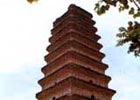 The Small Wild Goose Pagoda is located in the Jianfu (Felicity) Temple
at about 1.5 km outside the south gate of Xi'an. The Jianfu Temple was
originally the residence of Princess Xiang Cheng, a daughter of Emperor
Tai Zong (Li Shimin), which covers half of the area of Kai Huafang Lane.
The Small Wild Goose Pagoda is located in the Jianfu (Felicity) Temple
at about 1.5 km outside the south gate of Xi'an. The Jianfu Temple was
originally the residence of Princess Xiang Cheng, a daughter of Emperor
Tai Zong (Li Shimin), which covers half of the area of Kai Huafang Lane.
The Jianfu Temple was built in 648 AD to pay homeage to the Emperor Li
Zhi of Tang dynasty upon the centenary of his death by his son Emperor
Rui Zong, Li Dan. Therefore, it was originally named "The Xianfu
Temple (The Temple of Offering Happiness)". Six years later, the
Empress Wu Zetian took the throne by deposing her son (the Emperor). In
order to show her memorial of her dead husband, the Xianfu Temple was
renamed the Jianfu Temple and the name still being used now.
The Jianfu Temple had been damaged and tattered and tattered because
of the year-round wars in the later Tang dynasty, so the temple was moved
to the southern yard (that is the Tower Yard). The present Jianfu Temple
has been formed and established after the remedy and maintenance of dynasties
from the Song, Yuan, Ming and Qing.
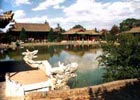 Huaqing Palace is located at the foot of Lishan Mountain, about 30 kilometers
east away from Xi'an City. Lishan Mountain, with the elevation of 1,256
meters, is a extinct volcano and looks very much like a black green galloping
horse from a long distance. Hence its name, Lishan Mountain. 3,000 years
ago, the King of Western Zhou had a palace built against the mountain
because of the hot spring at the foot of the mountain. In the 8th century
BC on the top of the mountain, King You of the Western Zhou Dynasty set
fire at the beacon tower and fooled his sovereign rulers in order to see
a smile on the face of Baosi, his most favorite concubine. As the result,
King You was killed by Quanrong (a then minority tribe) and his state
was overthrown. This is a very famous story called "The Sovereign
Rulers Are Fooled By The Beacon Tower" in China's history. Accroding
to the legend, Qin Shihuang, the first Emperor of the Qin Dynasty , was
spat and got sores on his face because he wanted to take liberties with
a fairy maiden. And then the fairy maiden forgave him and hinted him to
wash his sore face in the hot spring. To his surprise, his faces become
well soon. So the Hot Spring was also called "Fairy Lady Spring".
This Hot Spring was the resort palace of many emperors in following dynasties.
Especially, Emperor Xuan Zong (Li Longji) of the Tang Dynasty had more
luxurious palaces built over the hot spring around the mountain in the
period of Tian Bao (724-756 AD) and named it Huaqing Palace, which was
destroyed due to wars and long time. The Huaqing Hot Spring Palace that
we can see today was rebuilt on the site of the Qing Dynasty structure
after 1949.
Huaqing Palace is located at the foot of Lishan Mountain, about 30 kilometers
east away from Xi'an City. Lishan Mountain, with the elevation of 1,256
meters, is a extinct volcano and looks very much like a black green galloping
horse from a long distance. Hence its name, Lishan Mountain. 3,000 years
ago, the King of Western Zhou had a palace built against the mountain
because of the hot spring at the foot of the mountain. In the 8th century
BC on the top of the mountain, King You of the Western Zhou Dynasty set
fire at the beacon tower and fooled his sovereign rulers in order to see
a smile on the face of Baosi, his most favorite concubine. As the result,
King You was killed by Quanrong (a then minority tribe) and his state
was overthrown. This is a very famous story called "The Sovereign
Rulers Are Fooled By The Beacon Tower" in China's history. Accroding
to the legend, Qin Shihuang, the first Emperor of the Qin Dynasty , was
spat and got sores on his face because he wanted to take liberties with
a fairy maiden. And then the fairy maiden forgave him and hinted him to
wash his sore face in the hot spring. To his surprise, his faces become
well soon. So the Hot Spring was also called "Fairy Lady Spring".
This Hot Spring was the resort palace of many emperors in following dynasties.
Especially, Emperor Xuan Zong (Li Longji) of the Tang Dynasty had more
luxurious palaces built over the hot spring around the mountain in the
period of Tian Bao (724-756 AD) and named it Huaqing Palace, which was
destroyed due to wars and long time. The Huaqing Hot Spring Palace that
we can see today was rebuilt on the site of the Qing Dynasty structure
after 1949.
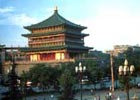 In the center of Xi'an, at the intersection of the north, the south, the
east and west street stands the Tower, and to the four dirctions from
it along the four streets to the city wall stand four city gate towers.
In the center of Xi'an, at the intersection of the north, the south, the
east and west street stands the Tower, and to the four dirctions from
it along the four streets to the city wall stand four city gate towers.
The Bell Tower is a square-shaped construction with the height of the
36 meters, built on the 8-meter-high blue brick base with for corridors
connected together. It occupies and area of 1,377 square meters. The Bell
Tower was originally built in the Guangji Street 0.5 kilometer west of
the Drum Tower in the 17th year of Hong Wu period of the Ming Dynasty
(1384 AD). In 1582 AD, supervised by the city governor Gong Xinxian, it
was moved to the present-day site. The tower is five-room long and wide,
together with a seven-room surrounding corridor on the upper floor. Three
storeys of eaves seen from the exterior of the building, but the interior
of the building has only two storeys. The upturned eaves are supported
by colorful dougong (a unique of Chinese architectural style). The whole
tower is a wooden structure with mortise and tenon jointed without a single
iron nail. The three layers of eaves are covered with blue glazed tiles,
the beams and columns of the upper and lower rooms are decorated with
colour paintings. The top part of the tower is 5 meter high, with a gold-tiled
roof. All this makes the tower look magnificent and grand.
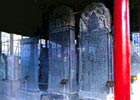 Once the Temple of Confucius, the Forest of Steles at Sanxuejie Street
nearby the South Gate in Xi'an was originally built in Northern Song dynasty
(1090 A.D.) when a large Confucian collection of steles cut in A.D. 837
- the oldest existing texts of the Confucian classics - was moved here
for safekeeping. It gained the present name in the 18th century and boasted
the largest collection of its kind in China.
Once the Temple of Confucius, the Forest of Steles at Sanxuejie Street
nearby the South Gate in Xi'an was originally built in Northern Song dynasty
(1090 A.D.) when a large Confucian collection of steles cut in A.D. 837
- the oldest existing texts of the Confucian classics - was moved here
for safekeeping. It gained the present name in the 18th century and boasted
the largest collection of its kind in China.
The contents of the Forest Steles can be divided into four groups: works
of literature and philosophy, historical records, calligraphy and pictorial
stones.
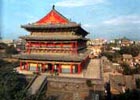 In the center of Xi'an, in the West street, 400 meters west of the Bell
Tower, stands the Drum Tower.
In the center of Xi'an, in the West street, 400 meters west of the Bell
Tower, stands the Drum Tower.
The total height of the Drum Tower is 33 meters, in a rectangular shape
with tiers of upturned eaves and a gold-tiled roof. It was built in the
13th year of Hongwu period (1380 AD). There used to be a huge drum on
the tower, which told time in cooperation with the huge bell on the Bell
Tower. There is one of the busiest roads passing through under the tower
for traffic to go back and fro in the north-south direction.
The Drum Tower is a very strong and solid building. It has withstood
more than ten earthquakes for over 500 years and there is not a single
crack appearing on it, and now it is still standing on its original site.
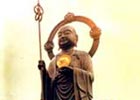 Daxingshan Temple once was the greatest Buddhist establishment of the
Sui and Tang dynasties, but since the tenth century it has been destroyed
and rebuilt several times.
Daxingshan Temple once was the greatest Buddhist establishment of the
Sui and Tang dynasties, but since the tenth century it has been destroyed
and rebuilt several times.
The latest reconstruction was built in 1956. Today, its possession has
been turned into a small, quiet and charming park. The main buildings
have been repainted and a handful of monks live and worship there.
The history of this temple can be traced back to the third century, and
its original name was Zunshan Temple. During the Sui dynasty, it was rebuilt
and was given its present name. Since then, it gradually became the headquarters
of an order with a network of 45 prefectural temples, which were all established
by Yang Qian, the founder of the Sui dynasty. During the Tang dynasty,
it became a great center of Buddhist art and learning. However, during
the Buddhist persecution of 841-845, most of the buildings were destroyed,
and even the survived also disappeared at the end of the Tang. In Ming
dynasty, the temple was rebuilt and again
restored in 1785 by an expert in Tang-dynasty Chang'an called Bi Yuan
(1730-97). After its reconstruction in 1956 it was used by a community
of Lamaist monks until the Cultural Revolution (1966-76). Today it houses
the Xi'an Buddhist Association.
The temple and Xinfeng Park are located south of the Little Goose Pagoda
on a small street called Xingshan Si jie, behind the open market of Xiaozhai.
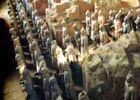 The Terra-cotta Warriors and Horses in Xi'an are known as "the Eighth
Wonder of the World" and listed in the World Cultural Heritage List.
In March 1974, peasants in Xiyang Village came across a piece of an earthen
figure when digging a well, leading to the discovery of Pit No.1 in the
present Terra-Cotta Warriors Museum. In the summer of 1976, pits No.2
and 3 were located. Over 7,000 individual pottery soldiers, horses, chariots
and weapons have been identified in the three pits.
The Terra-cotta Warriors and Horses in Xi'an are known as "the Eighth
Wonder of the World" and listed in the World Cultural Heritage List.
In March 1974, peasants in Xiyang Village came across a piece of an earthen
figure when digging a well, leading to the discovery of Pit No.1 in the
present Terra-Cotta Warriors Museum. In the summer of 1976, pits No.2
and 3 were located. Over 7,000 individual pottery soldiers, horses, chariots
and weapons have been identified in the three pits.
The warriors and horses were sculptured to protect the tomb of Qin Shihuang
(the First Emperor). By 221 B.C., he defeated six countries in less than
ten years, concluding the chaos of more than 500 years known as the Warring
States Period. By this time, China's first-ever centralized feudal power
was founded and laid a solid basis for the rapid development of economy,
politics, ideology and culture. Qin Shihuang founded its capital in Xi'an,
and created one of the greatest ancient cities the world has ever known.
|
|
 |
Travel
Guides |
|
|
 |
|

